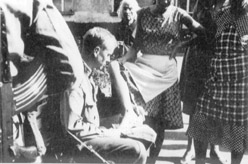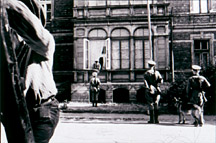
Latvia/Germany, 1998
Director, Screenplay: Laila Pakalnina
Latvian and Russian with English subtitles
Festivals: Cannes (Un Certain Regard), Toronto, Singapore
83 minutes
 Belonging to the cinema of inactivity - this film revels in its provincialism, taking its time to lead the audience through a small coastal town in Russian-occupied Latvia, just after WW2. Paranoid of Swedish spies, the Russians plough the beach each night so intruders can easily be detected by their footprints. The film starts with three soldiers on their morning rounds, finding a woman's shoe on the beach. They fire a flare, a siren starts clamouring and the film begins. Soldiers quickly fill the screen and search parties are sent out to track down all suspicious looking women.
Belonging to the cinema of inactivity - this film revels in its provincialism, taking its time to lead the audience through a small coastal town in Russian-occupied Latvia, just after WW2. Paranoid of Swedish spies, the Russians plough the beach each night so intruders can easily be detected by their footprints. The film starts with three soldiers on their morning rounds, finding a woman's shoe on the beach. They fire a flare, a siren starts clamouring and the film begins. Soldiers quickly fill the screen and search parties are sent out to track down all suspicious looking women.
Mixing elements of farce and objective documentary, the film is initially disconcerting, and several people walked out after the first half hour, rubbing their eyes and shaking their heads, wondering just what the hell they had just sat through. What they missed out on was a very dry, but clever film. It is essentially a film about filmmaking, structured around a very simple story - three Russian soldiers and their dog sent out to find a girl to fit the shoe. But it is the B&W photography and superb technique that dominates the viewer's experience of this film. The camera behaves as if it was a of disinterested elderly guide navigating its herd of tourists through the town, detachedly pointing out amusing details in the everyday lives of the townsfolk and troops. Everyone we are introduced to is preoccupied and unresponsive, as if they were no different from the cats and dogs and cobblestones. There is no character development and little audience identification as the camera trails after the three soldiers and their dog, in fact it behaves like a dog, sniffing around and ferreting out details until it is called back to the main action. As the alsation,Wilja, frequently runs off to chase cats and sniff people, so does the camera wander off distractedly to film toys, vegetables, bored locals. It seems to spend most of its time figuring out how to frame these objects, often reframing to different angles and distances, taking in a vast excess of scenery, with long establishing shots thrown in before simple actions like walking across a yard, or going up the stairs. It lingers at the end of each scene, recording facial expressions long after the action has finished, like a contented dog wagging its tail in the doorway. Eventually the three soldiers move on, and the camera silently tags along - as unacknowledged as the everpresent cameraman of direct cinema. Being Russian, the soldiers have communication problems with the locals, and often seem as clueless as the audience. They stop frequently to soak in the sun, have a drink and smoke, read posters and relax. And yet the projector whirrs on and on and on... patiently accumulating details until suddenly you realise what an unusual and fascinating film this is, and the fun begins.
The film is composed primarily of streetscenes - a large woman washing mushrooms by the waterpump drops one in the gutter, a boy with an armful of beer bottles smashes one on the pavement, a soldier buys a comb from a newsstand. All the mundane things that usually happen off camera become farcical in the orchestral framework of this film - the accidental and incidental become its subject - not the soldiers or their search for the owner of the shoe. The film celebrates the spectacle of the everyday, of time outside the film, except this time it is the film - empty streets, children playing, women working, kittens and puppies toddling around. It becomes a film about what happens when the main characters are removed from the plot, and the cameraman decides to film it anyway. A looking for Godot. All we are given are short, beautiful glimpses. We see a child on his tricycle, staring at his front wheel. One of the soldiers gives him a sweet before walking off, yet the camera stays glued to his face for a good minute. Attenuated close-ups of complete strangers playfully suggest we can read our own story into the movie. We see sailors parading down an empty street in perfect formation, they lead us to a crane lifting a car out of a river. Then it cuts back to the soldiers, who are resting on a patch of grass. There is no further mention of sailors or cranes or cars. Then why show it to us? 'Why not?' seemes to be the cry of this film. Its soviet-style constructivism is more ironic than pretentious (in contrast to Theo Angelopoulos' Ulysses Gaze), all it seems to be saying is if you look at something long enough, it becomes very interesting. And the mundanities of life in a provincial village are rich with these wry insights.
There is little dialogue in the film, but when it occurs, it is amusingly banal. "Faster Faster" a sergeant instructs his men. "Tell it to your wife" is the reply. With no music, the soundtrack is an impressive scene-builder, at times overdubbing off-screen sound to build up expectations, cutting to a sudden silence when the source of that sound is suddenly revealed, and the three men we heard arguing are seen frozen at the far end of a room, staring straight into the camera, frozen in tableau as if posing for a family portrait. And as the camera pans wildly from tree to tree to house to house in a point-of-view binocular shot, we hear the soldier humming mindlessly as he scans the area, Wilja barking in the background, the sounds of a factory somewhere nearby, people talking down in the street, someone sawing wood, schoolchildren playing. It provides hints and linkages. Later we visit that factory, see the man sawing the wood, the children in school. The soundtrack is naturalistic in that it imparts a sense of space and proximity. We hear trucks coming and going, dogs barking, girls singing, a basketball bouncing, footsteps running, machinery clanking and whirring, whether we see it or not. The pattern of these sounds establishes a rhythm, slows the film down to a Sunday afternoon stroll, lackadaisical, patient, warm and relaxed. A film that provides many points of entry without being too obscure. It involves instead of irritating. The binoculars flash to a rooftop. "Cheep Cheep" the voiceover intones, and the audience laughs, noticing a seagull next to the chimney. "Cheep Cheep" and the bird flies away. The camera continues its gleeful movement.
 Striking tableaus and portraits, purposeful panning and tracking shots, static long takes give a painterly feel to the movie, there is so much detail built into each shot. The slow panning shots across table tops, up and down staircases, through laneways and gardens reminded me of Peter Greenaway's films - you need patience and an eye for detail to get the jokes in the film... it might be a slight wince in someone's face at the end of a thirty second take, or the way a kitten suddenly waddles into frame, stealing the viewer's attention away from the off-screen dialogue and disrupting the still-life composition. As the movie progresses from morning to mid-afternoon, time seems to crawl to a halt. The first half of the film is very industrious, with bodies in motion, the machinery of the state alluded to in the loving attention given to bicycle gears, a man working in a manhole, a home economics class in the school, the ladle factory, the slaughterhouse, every home is a bustle of activity. The townsfolk are all engaged in productive work - cooking, chopping, mending and cleaning - or concentrating wordlessly, single-mindedly on sawing, walking down the street, carrying bottles, buckets, reading the newspaper, talking on the telephone, riding a bike, cleaning windows or mushrooms, looking for a lost pet. But as the morning sun rises and the shadows shorten, the soldiers become more and more distracted by their surrounds, they stop to read signs, buy drinks, chat up girls. When their commander puts the fear of God into them they drive madly around until their car runs out of gas and they have to push it back to headquarters. Old folk lean out of windows, teenagers drink beer in the park, the soldiers doze in a sunny patch of grass and the movie ends with a sly wink as a young girl runs out across the beach to wet her toes, leaving another shoe to start another story.
Striking tableaus and portraits, purposeful panning and tracking shots, static long takes give a painterly feel to the movie, there is so much detail built into each shot. The slow panning shots across table tops, up and down staircases, through laneways and gardens reminded me of Peter Greenaway's films - you need patience and an eye for detail to get the jokes in the film... it might be a slight wince in someone's face at the end of a thirty second take, or the way a kitten suddenly waddles into frame, stealing the viewer's attention away from the off-screen dialogue and disrupting the still-life composition. As the movie progresses from morning to mid-afternoon, time seems to crawl to a halt. The first half of the film is very industrious, with bodies in motion, the machinery of the state alluded to in the loving attention given to bicycle gears, a man working in a manhole, a home economics class in the school, the ladle factory, the slaughterhouse, every home is a bustle of activity. The townsfolk are all engaged in productive work - cooking, chopping, mending and cleaning - or concentrating wordlessly, single-mindedly on sawing, walking down the street, carrying bottles, buckets, reading the newspaper, talking on the telephone, riding a bike, cleaning windows or mushrooms, looking for a lost pet. But as the morning sun rises and the shadows shorten, the soldiers become more and more distracted by their surrounds, they stop to read signs, buy drinks, chat up girls. When their commander puts the fear of God into them they drive madly around until their car runs out of gas and they have to push it back to headquarters. Old folk lean out of windows, teenagers drink beer in the park, the soldiers doze in a sunny patch of grass and the movie ends with a sly wink as a young girl runs out across the beach to wet her toes, leaving another shoe to start another story.
eugene chew
comments? email the author
read eugene's review of the controversial french film I Stand Alone
return to the 1999 Sydney Film Festival index